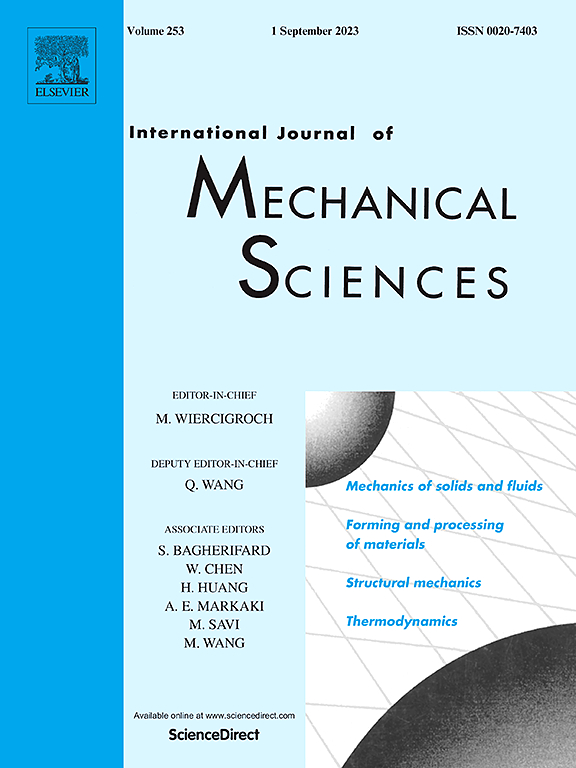MD benchmarks: Size-dependent tension, bending, buckling, and vibration of nanobeams
IF 7.1
1区 工程技术
Q1 ENGINEERING, MECHANICAL
International Journal of Mechanical Sciences
Pub Date : 2025-04-27
DOI:10.1016/j.ijmecsci.2025.110316
引用次数: 0
Abstract
Nonclassical continuum mechanics-based modeling of small-scale structures, such as micro- and nanobeams, is a research topic that has been extensively studied and is beneficial for designing intelligent devices. The accuracy of size-dependent beam models remains unverified in many cases in the literature due to the lack of experimental and molecular dynamics (MD) results at small scales. This paper aims to provide comprehensive MD benchmark solutions that facilitate the verification of nonclassical continuum models for miniaturized beams under tension, bending, buckling, and free transverse vibration. Size-dependent Young’s moduli, bending stiffnesses, buckling loads, and natural frequencies are presented through large-scale MD simulations involving up to one million atoms for silicon (Si) nanobeams with square, rectangular, and circular cross-sections. Bending and buckling analyses are conducted on clamped–clamped nanobeams, while a nanocantilever configuration is employed for the vibration analysis. Additionally, novel MD results are presented on the size effect in deflection profiles under bending, as well as buckling and vibrational mode shapes. The size effects resulting from scaling (where all dimensions of the nanobeams change proportionally) and independent variations in thickness, length, and width are systematically investigated. The mechanical problem, aspect ratio, and the cross-sectional geometry of the nanobeams influence the size effect. It is less sensitive to variations in length and weaker in nanobeams with rectangular cross-sections compared to those with circular ones. In all cases, silicon nanobeams exhibit a softer mechanical response as their dimensions decrease, consistent with the size effect previously observed in experiments and atomistic simulations.

MD基准:纳米梁的尺寸依赖性张力、弯曲、屈曲和振动
基于非经典连续介质力学的小尺度结构(如微纳米梁)建模是一个得到广泛研究的研究课题,有助于智能设备的设计。由于缺乏小尺度的实验和分子动力学(MD)结果,在文献中许多情况下,尺寸相关光束模型的准确性仍未得到验证。本文旨在提供全面的MD基准解决方案,以方便验证受拉、弯曲、屈曲和自由横向振动的小型化梁的非经典连续介质模型。尺寸相关的杨氏模量、弯曲刚度、屈曲载荷和固有频率通过涉及多达一百万个原子的硅(Si)纳米梁的方形、矩形和圆形横截面的大规模MD模拟来呈现。对夹紧型纳米梁进行弯曲和屈曲分析,采用纳米悬臂结构进行振动分析。此外,在弯曲、屈曲和振动模态振型下挠度剖面的尺寸效应方面,提出了新的MD结果。系统地研究了由缩放(纳米梁的所有尺寸按比例变化)和厚度、长度和宽度的独立变化引起的尺寸效应。力学问题、宽高比和纳米梁的横截面几何形状影响尺寸效应。相对于圆形截面的纳米梁,矩形截面的纳米梁对长度变化的敏感性较低。在所有情况下,随着硅纳米束尺寸的减小,它们表现出更柔和的机械响应,这与之前在实验和原子模拟中观察到的尺寸效应一致。
本文章由计算机程序翻译,如有差异,请以英文原文为准。
求助全文
约1分钟内获得全文
求助全文
来源期刊

International Journal of Mechanical Sciences
工程技术-工程:机械
CiteScore
12.80
自引率
17.80%
发文量
769
审稿时长
19 days
期刊介绍:
The International Journal of Mechanical Sciences (IJMS) serves as a global platform for the publication and dissemination of original research that contributes to a deeper scientific understanding of the fundamental disciplines within mechanical, civil, and material engineering.
The primary focus of IJMS is to showcase innovative and ground-breaking work that utilizes analytical and computational modeling techniques, such as Finite Element Method (FEM), Boundary Element Method (BEM), and mesh-free methods, among others. These modeling methods are applied to diverse fields including rigid-body mechanics (e.g., dynamics, vibration, stability), structural mechanics, metal forming, advanced materials (e.g., metals, composites, cellular, smart) behavior and applications, impact mechanics, strain localization, and other nonlinear effects (e.g., large deflections, plasticity, fracture).
Additionally, IJMS covers the realms of fluid mechanics (both external and internal flows), tribology, thermodynamics, and materials processing. These subjects collectively form the core of the journal's content.
In summary, IJMS provides a prestigious platform for researchers to present their original contributions, shedding light on analytical and computational modeling methods in various areas of mechanical engineering, as well as exploring the behavior and application of advanced materials, fluid mechanics, thermodynamics, and materials processing.
 求助内容:
求助内容: 应助结果提醒方式:
应助结果提醒方式:


